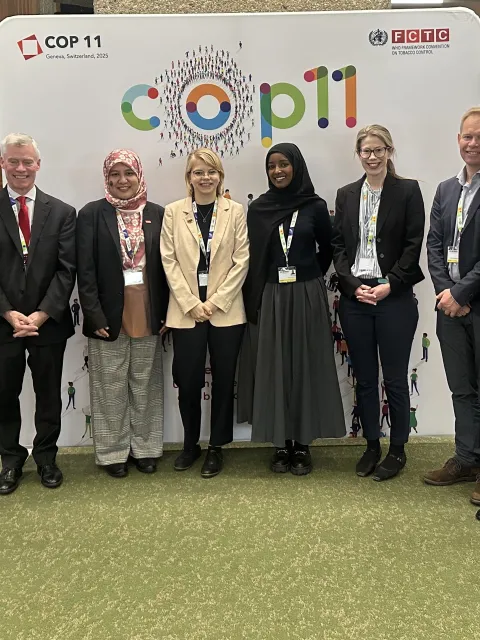The smokescreen of the tobacco industry's use of science
Tobacco industry claims that it is moving away from harmful smoke products and investing in health care are undermined by conflicts of interest and the manipulation of information and science.

Tobacco smoke contains more than 250 harmful chemicals as well as nicotine, which makes it difficult for people to stop smoking even when they are aware of the health risks. Not only has the tobacco industry known this for many years, it has actively sought to maintain its customer base captive by manipulating tobacco crops and using other methods to increase the addictiveness of products containing nicotine.
Big Tobacco also enacts a now well-known and continually updated playbook to market aggressively to adolescents – a particularly vulnerable age when many start smoking – to capture a new generation of customers.
At the same time, the industry is increasingly engaging in corporate social responsibility actions to whitewash its reputation. These include claims to support a “smoke-free world”, attending international events with discussions on health and investing in health to end its production of tobacco products. Most alarmingly, it uses research and science to advance its interests, misleading policymakers and the general public alike – and has been doing so in advertising as far back as the 1950s.
PMI’s move into the health industry with its takeover of Vectura, a company that makes medicines for chronic obstructive pulmonary disease (COPD) and asthma, is a striking example of corporate whitewashing.
PMI’s expressed desire to divest its cigarette business and become a “wellness company”, supported by its call for a ban on the production and sale of cigarettes, is contradicted on the one hand by its political interference to oppose stricter regulation in many countries and by its continued use of aggressive tactics to sell cigarettes (particularly in low-resource settings like Jordan), on the other by the use of its usual tactics to market its novel products – heated tobacco (HTPs) and e-cigarettes – as “safer alternatives”.
In fact, while the harms may be of a different nature, research highlighting the health risks associated with the consumption of HTPs and e-cigarettes is increasingly proving these products to be anything but safe. The tobacco industry is also particularly adept at using social media to showcase its novel products in a glamourous light and attract youth.
Tobacco industry and pseudoscience
“The tobacco industry has a long history of using unethical methods to market and sell its tobacco products. For more than 50 years, the industry has manipulated scientific language and imagery to add confusion to the global tobacco control narrative and mislead consumers and policymakers. The industry knows only one objective - to sell its highly profitable cigarettes to existing and new generations, regardless of the harms to the health of their customers and to society more broadly.”
– Nick Grant, Member of UICC's Board of Directors
The tobacco industry has been seeking since the 1950s to influence science by funding research that supports its business interests and by suppressing and criticising research that unfavourable to its positions. These attempts to present scientific research as credible and unbiased is a clear conflict of interest when they fund the very same research that advances their interests – notably on the relative harms of novel tobacco products.
The Foundation for Smoke-Free World, for instance, was established and is funded by PMI, yet nowhere on the website is this information apparent. Its claims, therefore, to be an “independent” foundation presenting unbiased research is at best misleading. The intent is to clearly present the dangers of combustible tobacco products, while promoting its smokeless products and seeking to prevent their strict regulation.
The industry’s ability to undermine public health information and confuse and divide the health community is particularly effective when research is published in peer-reviewed scientific journals. In June 2021, research suggesting that e-cigarettes are a highly effective cessation tool and safer alternative for smokers made waves – before it was revealed that the study was funded by Juul, a manufacturer of vaping products.
Some journals refuse to publish research funded by the tobacco industry, as they consider such research “tainted” by industry influence. Others, while perhaps requiring disclosure of conflict of interest, say that the research should be based on the data itself, not the source.
However, the tobacco industry has been known to manipulate the data. For instance, when the dangers of second-hand smoke started to emerge, the tobacco industry-funded research to prove that second-hand smoke posed little or no harm – by misclassifying study subjects in terms of their exposure to second-hand smoke.
Other tactics include how the study question is framed or changing the standards for scientific research, as well as having editorial board members of scientific journals with ties to the industry. The implications can be far-reaching, as highlighted by a 2006 study into how tobacco industry influence of science and scientists in Germany has been a factor in the country’s opposition to stricter tobacco regulation.
In essence, the basis of the tobacco industry’s strategy to market its products and burnish its reputation is, on the one hand, to offer a veneer of science defending its viewpoint and legitimising its activities and, on the other, to suggest it is moving into new, healthier markets. Yet none of this can be trusted with such clear conflicts of interest and a history of manipulating public opinion.
Last update
Monday 09 May 2022
